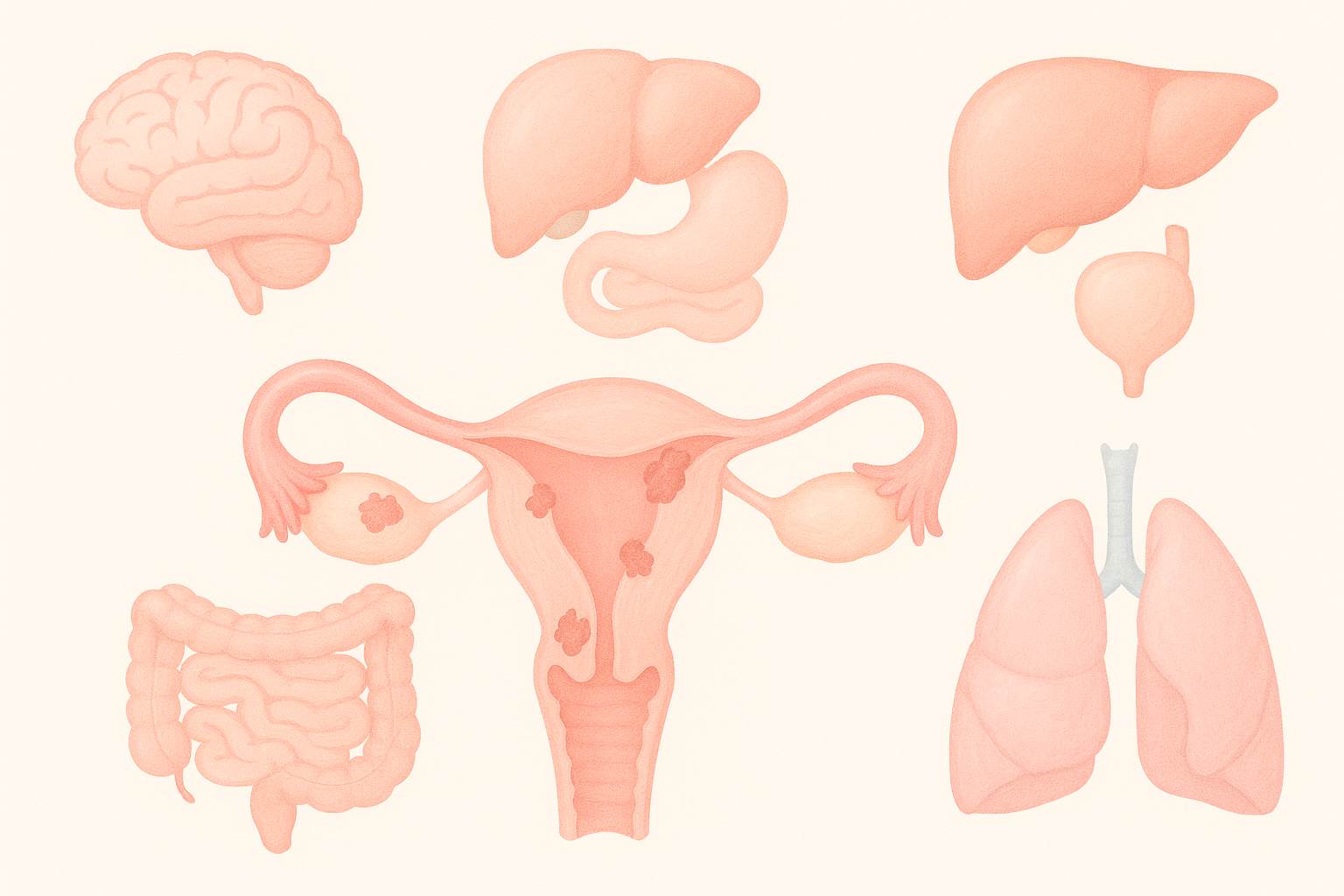Endometriosis: When Period Tissue Grows Where It Shouldn't

Endometriosis: When Period Tissue Grows Where It Shouldn't
Clitoria Sexual Health Clinic Pelvic exams at Petchkasem 81, Bangkok
Friendly doctors Private, home-like atmosphere Sex-positive, judgment-free care
Endometriosis occurs when endometrial-like cellsnormally inside the uterusgrow elsewhere (e.g., ovaries, uterine wall, bowel, lungs, bladder).
With each cycle these cells respond to hormones, causing inflammation, bleeding, pain, and adhesions.
Many people endure severe period pain without realizing endometriosis is the cause.
What is endometriosis?
A chronic gynecologic condition in reproductive-age individuals (roughly 20-45).
Endometrial-like tissue grows outside the uterus; it thickens and sheds with periods but cannot drain, leading to inflammation and scar tissue buildup.
Where can Endometriosis occur?
Common sites include:
- Ovaries (endometrioma / chocolate cyst): dark blood-filled cysts, pelvic pain, infertility
- Peritoneum: chronic pelvic pain
- Uterine wall (adenomyosis): enlarged uterus, heavy and painful periods
- Fallopian tubes: adhesions affecting natural conception
- Bladder: urinary frequency/pain or cyclic hematuria
- Distal bowel/rectum: painful bowel movements or cyclical rectal bleeding
- Surgical scars (e.g., C-section): tender lump that worsens with menses
- Rare sites: umbilicus, lung, even brain (very rare) with cyclic symptoms

Causes & risk factors of Endometriosis
- Retrograde menstruation (menstrual flow pushed through fallopian tubes)
- Immune dysfunction that fails to clear displaced cells
- Family history/genetics
- Estrogen-dominant hormonal milieu
- Early menarche or short menstrual cycles
Symptoms of Endometriosis
- Severe or worsening period pain
- Deep pain with intercourse (deep dyspareunia)
- Chronic pelvic or low-back pain
- Pain with bowel movements or urination during periods
- Infertility or recurrent miscarriage of unknown cause
How endometriosis is diagnosed
- History and pelvic examination by a gynecologist
- Transvaginal ultrasound to evaluate endometriomas/adhesions
- MRI for deep infiltrating disease (e.g., bowel or uterine wall)
- Laparoscopy: gold standard for confirmation and treatment in one session
Treatment of Endometriosis
Goals: relieve pain, prevent adhesions, and preserve fertilitytailored to symptoms and life plans.
- NSAIDs: short-term pain control
- Hormonal therapy: combined pills, progestin-only methods, implants/IUD, or GnRH agonists/antagonists to suppress lesions
- Laparoscopic surgery: excision/adhesiolysis for infertility or refractory pain
- Fertility care: IVF/ART alongside disease management
Self-care & lifestyle
- Regular exercise to help modulate excess estrogen
- Anti-inflammatory diet: fish, leafy greens, whole grains
- Reduce caffeine, alcohol, and red meat
- Prioritize sleep and stress management
- Attend pelvic exams and ultrasound follow-ups
Endometriosis Assessment Fees
- OB-GYN consultation + pelvic exam: 1,390 THB
- Transvaginal ultrasound (TVUS): 1,990 THB
- Treatment & fertility planning consult: 1,390 THB
- Hormonal symptom control: Starting from 390 THB
Chronic period pain? Don't ignore it.
Clitoria Sexual Health Clinic Petchkasem 81, Bangkok
Tel: 081-116-3788
Line OA: @dr.clitoria
Frequently Asked Questions (FAQ) about Endometriosis
1. Whats the difference between endometriosis and a chocolate cyst?
Endometriosis refers to the overall condition where endometrial-like tissue grows outside the uterus, affecting many possible organs.
A chocolate cyst, or ovarian endometrioma, is one specific form of endometriosis where this tissue grows inside the ovary and forms a blood-filled cyst.
2. Is endometriosis hereditary?
Yes. Studies show a strong familial tendency, especially if a first-degree relative such as your mother or sister has had the condition.
Your risk can be 57 times higher than average (according to ACOG, 2022).
3. Can endometriosis really appear outside the uterus?
Yes. Endometrial tissue can implant in several areas such as the ovaries, intestines, bladder wall, abdominal wall, stomach, brain, or even cesarean-section scars.
In very rare cases, it can even appear in the lungs or navel, often causing cyclical pain, swelling, or bleeding at those sites during menstruation.
4. Can endometriosis be completely cured?
Theres currently no permanent cure, but symptoms can be well controlled with hormonal therapy and proper medical management.
In some cases, surgery may be needed to remove lesions improving quality of life and reducing complications such as adhesions or infertility.
5. Does pregnancy make endometriosis better?
Some women experience symptom relief during pregnancy due to high progesterone levels that suppress lesion activity.
However, this isnt a true cure symptoms can return after childbirth or when menstruation resumes.
6. Does having painful periods mean I definitely have endometriosis?
Not always. However, if your period pain gets progressively worse or disrupts your daily activities, its an important sign to see a gynecologist.
Other causes like ovarian cysts or pelvic adhesions may also be involved.
7. How is endometriosis diagnosed?
Diagnosis is based on a detailed medical history, physical or pelvic examination, and transvaginal ultrasound (TVUS).
If a deep lesion is suspected, MRI or laparoscopic surgery may be recommended for confirmation.
8. Are there treatment options besides surgery?
Yes. Combined oral contraceptives or progestin-only therapy (by pill, injection, or implant) can effectively suppress lesions and reduce pain for those not planning pregnancy.
Medication therapy is usually the first-line treatment before considering surgery for persistent or severe cases.
9. Can diet or lifestyle affect endometriosis?
Yes, lifestyle plays a role. An anti-inflammatory diet rich in fresh vegetables, fruits, whole grains, omega-3 fatty fish, and olive oil helps lower inflammation in the body.
Avoid high-fat foods, red meat, caffeine, and alcohol as they may worsen symptoms.
10. Can endometriosis turn into cancer?
The risk is very low (about 1%), mainly in women with long-standing or large ovarian endometriomas. Regular ultrasound follow-up as advised by your doctor is the best way to minimize risk.
If you experience unusually painful periods or suspect endometriosis,
consult our medical team at Clitoria Clinic, Phetkasem 81, Bangkok.
Tel: 081-116-3788
Meta Description: Learn about endometriosiscauses, symptoms, diagnosis, and treatment options to manage pain and protect fertility. Gentle, judgment-free gynecology at Clitoria Clinic, Petchkasem 81, Bangkok.
Keywords: endometriosis, severe period pain, endometrioma, chocolate cyst, adenomyosis, infertility, pelvic pain, transvaginal ultrasound, laparoscopy, endometriosis clinic Bangkok, Clitoria Clinic


